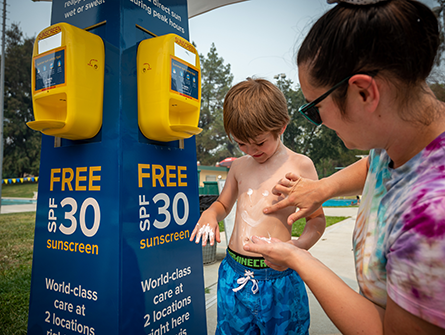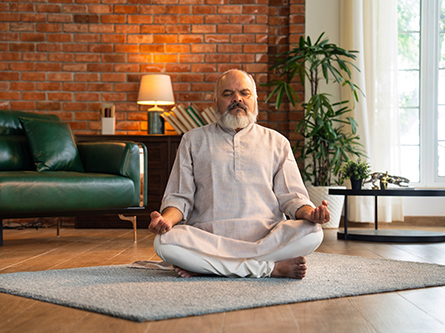
As summer approaches, we have some helpful reminders about sunscreen and why you should protect yourself and your family.
Skin cancer is the most common cancer in the U.S. and the world. More than 9,500 people are diagnosed with skin cancer each year in the U.S., according to the Skin Cancer Foundation. But skin cancer is also one of the most preventable cancers. There's a lot you can do to limit your exposure and risk.
Which SPF should I use?
Proper use of sunscreen is crucial to reducing the risk of sun damage and skin cancer. Sun protection factor (SPF) measures the sunscreen's ability to prevent damage from ultraviolet (UV) rays. UV is the range of light wavelengths that are not visible to the human eye.
But what do the numbers mean? If you are using SPF 30, it will allow 3% of UV rays into your skin. If you are using SPF 50, it will allow about 2% of UV rays through to your skin. Most dermatologists agree that it's best to use a sunscreen with an SPF of at least 30. Sunscreens with an SPF of 50 or higher offer minimal extra protection and may be more costly.
It's not just the SPF that matters. It's important to get a sunscreen that's water resistant and broad spectrum to block two basic types of UV rays: UVA and UVB. Both UVA and UVB rays are harmful. UVA rays penetrate deeper into the skin are play a greater role in skin aging. UVB rays are responsible for sunburns. Both UVA and UVB contribute to the development of skin cancers.
Sign up for our Health Highlights e-newsletter
What type of sunscreen is best?
It doesn't really matter which brand of sunscreen you use as long as it contains the right ingredients. Sunscreen has two main types of ingredients: physical blockers (zinc oxide and titanium dioxide) and chemical blockers (avobenzone, oxybenzone and others). Physical blockers, sometimes called mineral sunscreens, tend to have broader coverage. They're also effective immediately after being applied since they work by reflecting the UV rays. Chemical blockers need to be applied 20 minutes before sun exposure and work by absorbing UV rays.
While physical blockers tend to be thicker and can be more difficult to rub in compared to chemical blockers, they can usually be tolerated better by people with sensitive skin.
Learn more about the types of sunscreens from the Skin Cancer Foundation
How much sunscreen should I use?
You may have heard that amount of sunscreen you use should fill a shot glass. The truth is, people come in all shapes and sizes, so sunscreen needs vary. The key is to apply enough to generously cover all sun-exposed areas. Rub it in until you see a light, even film before it absorbs.
For many adults, this is typically 1 ounce (about a shot glass), while children may need about half that. But rather than focusing on an exact amount, aim for complete coverage.
It's important to remember that no sunscreen filters out all UV rays. Hats, protective clothing, and sunglasses are also good ways to help limit additional sun exposure.
How often should I apply sunscreen?
Any sunscreen you choose must be reapplied about every two hours. You should also apply more sunscreen if you've been sweating or after you've been in the water or toweled dry.
Be sure to cover all sun-exposed areas, including your ears, feet, ankles, and neck. If you are using bug spray, put it on after applying sunscreen.
Should I use spray sunscreen or lotion sunscreen?
Both spray-on and lotion sunscreens work well if used correctly and with the right amount. However, it can be difficult to get a good application with spray sunscreen, especially when it's windy. It's easy to miss some areas or not apply enough. Lotions seem to be a little easier to apply a thick, even coat.
Sprays can also be accidentally inhaled and cause irritation for some people. Anyone with asthma or other sensitivities should avoid sprays and avoid spraying it near their face. It's safest to spray it into your hands and then apply it to your face. Sprays can also make walking surfaces slick if the spray reaches the ground or floor.
What's the most harmful time of the day?
It's best to avoid being outside when the sun is directly overhead. That is typically between 10 a.m. and 4 pm.
If you are outside during this time, it's important to wear sunscreen and sun-protective clothing. Look for these key features in clothing that offer the best sun protection:
- Tightly woven or densely knit fabrics
- Dark or bright colors
- Long sleeves and full coverage
- Clothing labeled with a UPF (Ultraviolet Protection Factor) of 30 or higher
There are also certain environments that can lead to increased UV exposure. These include places at higher elevations or activities that involve water and snow, which often reflect UV light towards skin.
What's the best way to treat sunburns?
The most important thing to do is get out of the sun right away and minimize additional UV exposure. The redness from a sunburn typically shows up two to six hours after exposure and will peak in about 24 hours.
Here are other sunburn treatment options:
- Anti-inflammatory medications like ibuprofen or naproxen can help reduce swelling and redness from a sunburn.
- Use a moisturizer that contains aloe vera, which can soothe the skin.
- Apply a cool compress to the sunburned area.
- Drink plenty of water to prevent dehydration.
If you or your child develops blisters or skin peeling that covers a large part of the body, this breakdown of the protective skin barrier can increase your risk for skin infections. Seek medical attention if you see pus or discharge from blisters or areas of skin peeling or have signs of heat stroke. Symptoms of heat stroke could include confusion, fever, chills, fatigue, or severe hydration.
Find out if it's heat exhaustion or heat stroke
What kind of sunglasses are best?
Eye protection is important when out in the sun. If possible, choose sunglasses that have 100% UVA and UVB protection. A lot of sunglasses do not have adequate UV protection.
Some sunglasses have polarized lenses, which decrease glare from surfaces but do nothing to protect eyes from UV rays.
This blog was medically reviewed by dermatologist Oma Agbai.




